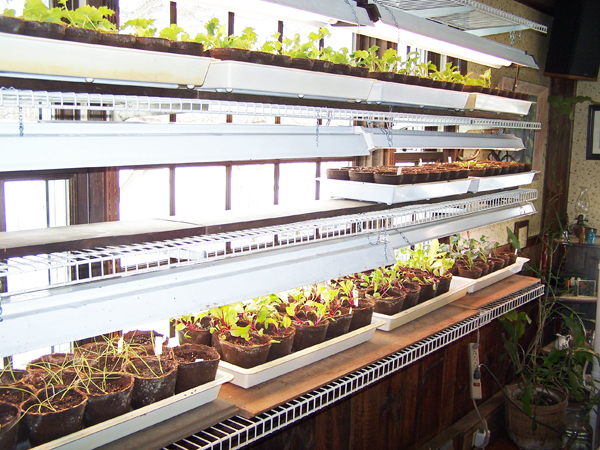
I’ve been starting around 1500 seedlings a year for over 25 years. In the beginning, seedlings did poorly. Most of this was cheap starting medium causing damping off and poor lighting. Over the years I have collected the array you will see in these photos, mostly from tag sales. I have very little $$ invested in all of this, perhaps $300 over 25 years.
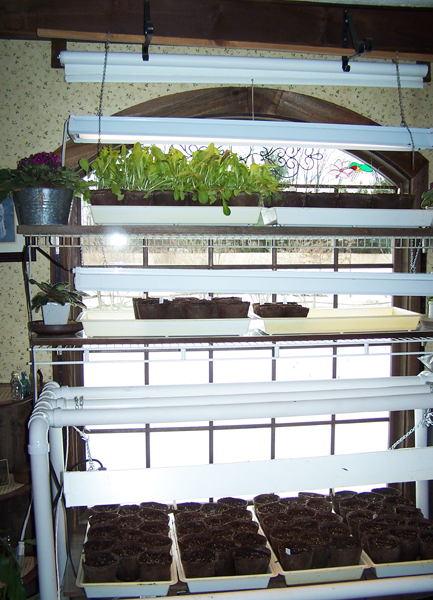
Because the seedlings did poorly, I started keeping notes, researching and figuring out what each type preferred. Some liked the gentle light of the top photo, which is an East window. Others needed the bright light of the Roundtop window, above, that is due South.
One thing I did find out is the information on the seed packets could be conflicting or just wrong. Buying 2 packets of the identical plant from 2 different companies could tell you to either start in sun or dark, warm temps or cold, deep in the soil or not covered at all, etc.
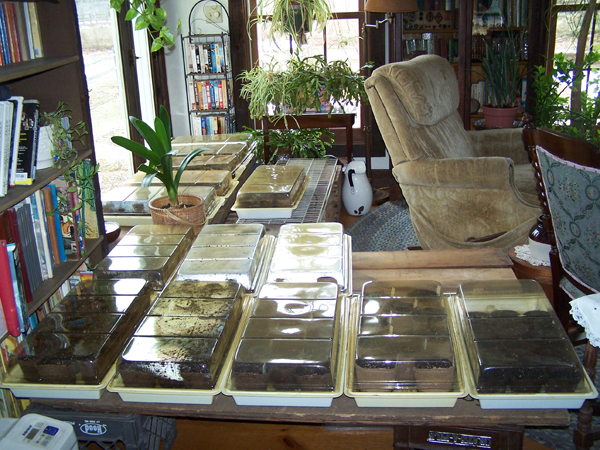
I did not have heat mats until about 3 years ago, as one doesn’t find them in tag sales. I was able to borrow the ones I used. This year I bought heat mats, the best I could afford. So most of the seedlings in the past were started as close to the wood stove as was safe, above.
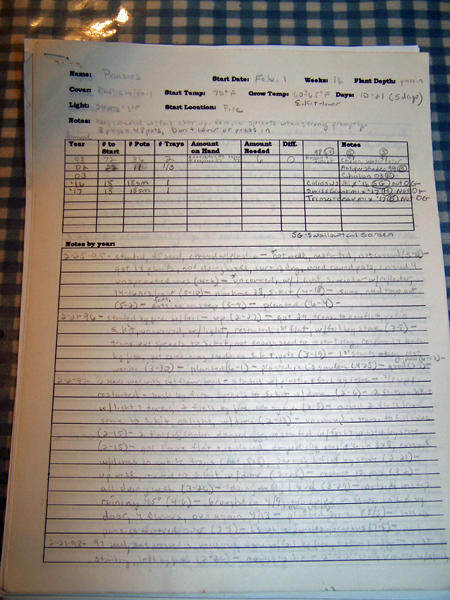
When I started teaching others about what we do here on the farm, they wanted the info I had compiled. I didn’t have it all in one place, but on the note sheet for each plant, above. This one is for Pansies, with a starting date of February 1. These notes go back to 1998, for each type of plant I grew.
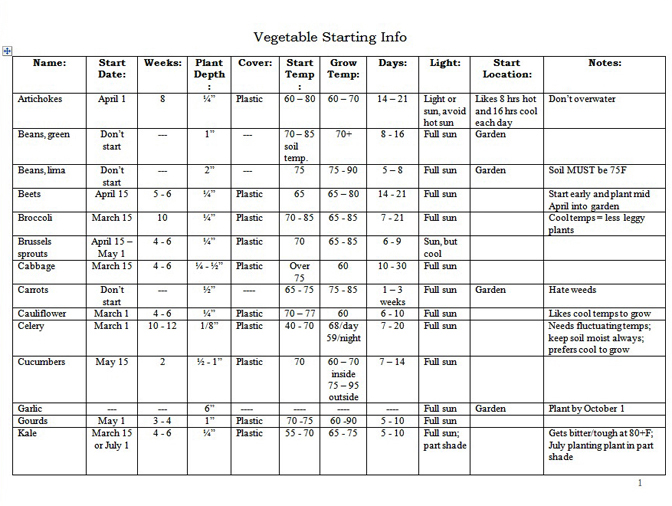
So I compiled the info from each sheet into a word.doc for Flowers, for Herbs and for Vegetables
With so many people wanting to grow vegetables, etc. this might be useful. But you should be aware that this is set up for my microclimate in New England with a Zone 4 growing season. You have to find out what your microclimate is and your Zone for growing and adapt it.
I also use John Kempf’s seed starting times, but these aren’t consistent in the above forms. For the start times I use of John Kempf’s: Flowers Herbs Vegetables
The link to John’s discussion about why to start seeds as he does is lengthy and involved. But it boils down to productivity of a single seed is in direct correlation to the stressors put on that seed from planting onward. It’s definitely a must read for anyone serious about raising their own food.
Starting a seedling too early subjects it to stressors of no room for roots to expand, handling of those roots, often lack of nutrients, and often improper lighting.
So by starting a seedling as close to 3 – 4 weeks from time of planting, using a last frost date that won’t stress the plant, is optimal.
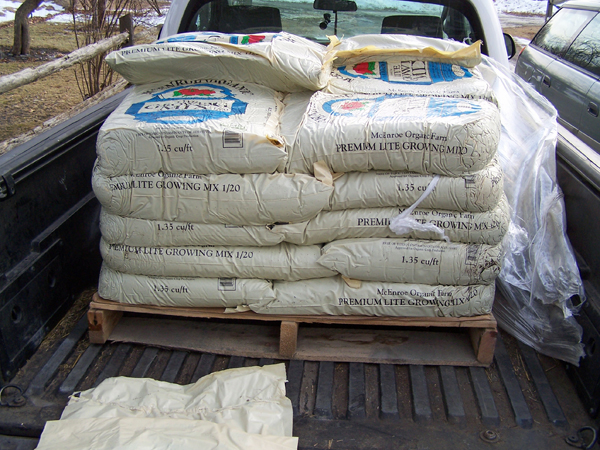
The next biggest problem I had was damping off. This is Wikipedia : “Damping off (or damping-off) is a horticultural disease or condition, caused by several different pathogens that kill or weaken seeds or seedlings before or after they germinate. It is most prevalent in wet and cool conditions.”
I went through many brands of seed starting medium before I found the one I use now. I have had zero damping off problems. It is an organic medium made in New York. I go once every 3 years and buy a truckload of it.
I use peat pots exclusively. I know it may not be the most environmentally friendly source, but I am trying to avoid handling roots as much as possible. That is another big stressor on a seedling. I use 3” pots for single plants, and 4” pots for those that need more room.
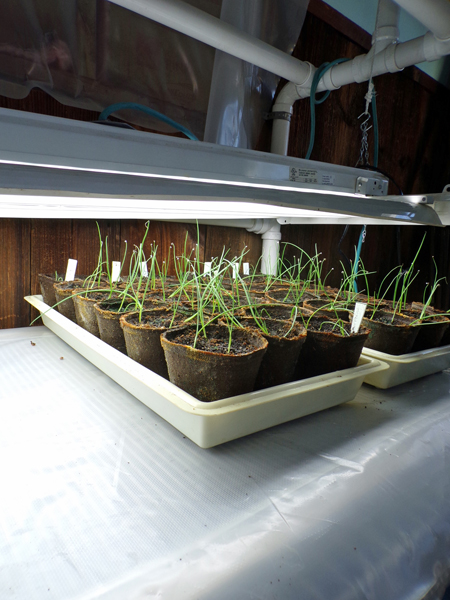
You might have noticed I use white trays exclusively. I started out with the dark colored ones, but the bright South sun would fry the little seedlings as the trays got very hot. I never have that problem with the white trays. Plus they are much easier to tell if they are really clean at the end of the season.
I used to use the cheap flimsy white ones. I grow in the house and these would inevitably develop holes and leak. So slowly I changed over to the PermaNest 10-20 trays. They do cost a lot more, but will last the rest of my life without leaking. The covers from the old trays don’t quite fit the PermaNest but they are close enough to do the job.
So I’ve covered starting times, starting medium, pots, trays, and heat. Next is lighting.
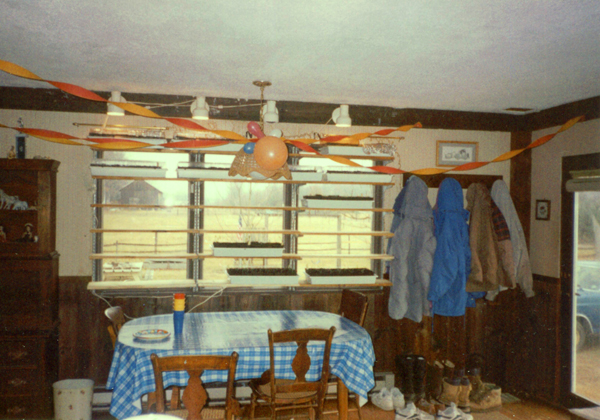
May 1998
Lighting is VERY important to growing seedlings. If they must stretch to reach enough light, the stems will be weak. Having the wrong lighting, even close enough, will slow growth.
In the above photo along the top of the wall, I used these plant lights I had found in a tag sale. They had hot incandescent spotlight bulbs. As a result I could not put them very close to the plants. I relied on the sun mostly. I had very stretched and weak seedlings.
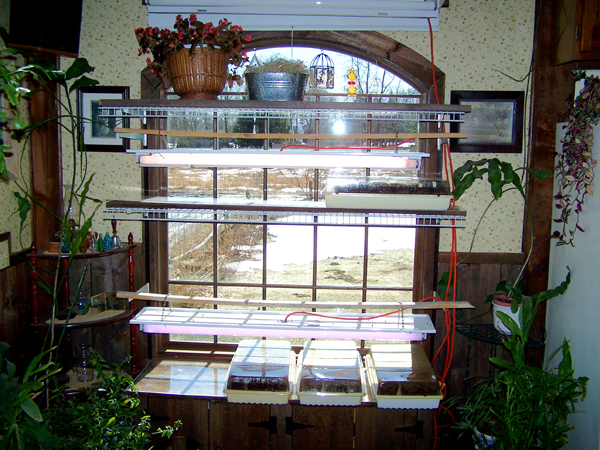
March 2009
In the late 1990’s my husband brought home from work some explosion proof 2 bulb florescent lights, T12 size, they were throwing out. These 4 very heavy fixtures were my only plant lights for many years. I had lucked out and found a whole case of 12 plant light bulbs at a tag sale for $10. These were marginally better than the incandescent lights but were hard to move to keep the correct height above seedlings.
Over the years I found more T12 fixtures at tag sales and when I joined BuyNothing I got a 4 bulb T12 fixture for free. Then someone offered some T5 4 bulb fixtures and I got several. I had to buy T5 bulbs for them. The difference the T5 made in the health of the seedlings was impressive. I’ve posted about it here and here.
I’ve heard good things about LED lights but due to my Lyme disease light sensitivity, I will not be trying them.
One other problem with raising seedlings is overcrowding. Seedlings need to NOT be competing for available nutrients when they are growing. So putting many seedlings in one pot, then trying to separate them to plant is HIGHLY stressful and your yields and health of the plants will show this.
If you are using a good starting medium, it will have enough nutrients for about 2 weeks once the seedlings come up. Then you need to feed, from the bottom, a good balanced feed. I use a mix of PlantSure, Seacrop, Neptune, Pepzyme, and AmorSi.
PlantSure covers all the bases from from plant production to plant protection. Contains ascorbic acid to zinc sulfate, from major nutrients, micronutrients, trace and ultra-trace elements. Incorporates diverse calcium, magnesium, and silicon minerals, biologicals, and humic substances.
Seacrop is derived from ocean water and is produced using a special process that removes most of the sodium while maintaining the plant availability of the minerals common in nutrient-rich ocean water. SeaCrop™ is loaded with magnesium, an enzyme cofactor vital to the formation of chlorophyll and efficient capture of sunlight.
Neptune is a blend of hydrolyzed fish and seaweed, ensuring a complete fertilization program.
Pepzyme stimulates the growth and metabolism of plant growth promoting microorganisms to break down organic matter and make soil nutrients such as phosphorus, nitrogen, calcium, iron, and more, available to plants in the forms they can absorb.
ArmorSi Silica benefits: Strengthens plants, improving plant stature which leads to advantageous exposure of leaves to light. Improves stress resistance, drought tolerance, heat and cold stress tolerance. Potassium benefits: Improves plant growth including structural and foliar growth, increases yield, improves flower and fruit production.
I feed when the soil starts to dry out on top, and only from the bottom, about every 3 - 4 days. I heat with wood, so it’s very dry in the house.
So for successful seed starting, use the best seed you can find, use the best medium you can find, avoid root stress in the many forms, feed the seedlings well using organic fertilizers, and provide the best lighting you can. Plan to be ready to plant them, after hardening them off for 5 days outside, right when they are ready to go into the ground.
Using these tools I’ve provided should ensure a good start for your seedlings.
Here’s another post I did on how I started seeds.
I’ve done many posts on prepping the soil for planting:
Soil Amending:
Part 1 here
Part 2 here
Part 3 here
Looks like you've really learnt a lot over the years. So many seedlings each year! How do you keep on top of it all?
By the way, how has your back been doing?
I keep lots of records, that's how! I have a schedule for the year and try to follow it as best I can.
My back flared up again 3 days ago, but is getting better again. Thanks for asking!
I've checked all the links! I had quite a time getting them right, as they insisted on changing to a previous one! If anyone notices they are not what they are supposed to be, please let me know and I will resume battle!
I'm struggling a lot with seedlings - and am trying to create new systems where they don't FRY under the hot Thai sun, and don't dry out even though I water x 2 every day. I have SO MUCH TO LEARN. Gonna read this post again quietly over coffee later and make a plan....
Your systems are really inspiring and in a world suddenly wanting to grow food, this information in soooo helpful. 100% from me. 😊🌱
An excellent post, particularly handy for people just starting out too! As usual, I'm amazed at your ingenuity and your record keeping. xx Just a reminder to use the #naturalmedicine tag too as we'll pick up posts like this if we see them as we like to support homesteaders like you!
Wow, so informative. Thank you for taking the time to share your knowledge. It's invaluable.
Thanks for sharing your creative and inspirational post on HIVE!
This post got curated by our fellow curator @tibfox and you received a 100% upvote from our non-profit curation service!
Join the official DIYHub community on HIVE and show us more of your amazing work!
This was super helpful for me! Exactly the kind of information I need right now.
I think my fertilizer is probably causing my seedlings to fail. Sprinkling organic stuff on the surface of the soil causes a breeding ground for molds to attack the top of the plant.
Maybe you can fix the links to your website to find the herb and vegetable pages. All three are linking to the same flower starting page.
Done, I hope!
And that's why I water from the bottom...
Oh my I do not do any of this and my seedlings never make it to the garden! Now I know why. I also think I may just let someone else make my seedlings this year too.
Great post!!!
This is fantastic information!!! Thank you so much for sharing.
I have a terrible track record with seedlings. 😅 I've managed to grow basil several times, but everything else dies slow and agonising deaths. Chives in particular. 😔
You've been visited by @minismallholding from Natural Medicine.
I’ve featured your post in The Lotus Garden newsletter, which will be published each Thursday.
The Lotus Garden is a newsletter supporting content relevant to Homesteaders & supported by Natural Medicine. Earn LOTUS & HIVE for your #homesteading content!
About II Discord II Community
Thanks!
Great info and wonderful to see such a productive operation!
Looks like your meticulous note taking has really paid off! Thanks for sharing!